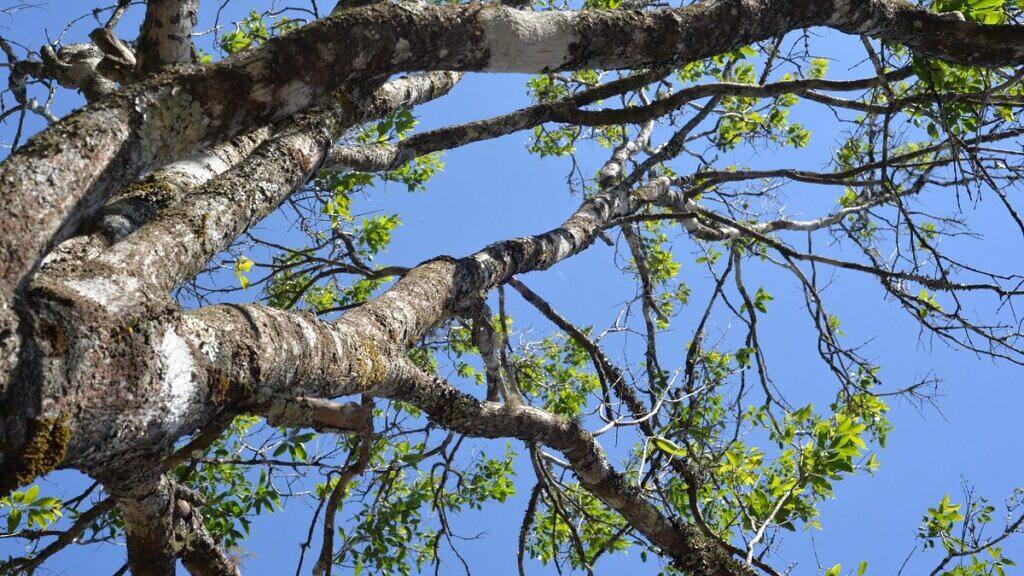Sandalwood (Santalum album) is an aromatic tree of invaluable worth, revered for millennia for both its medicinal properties and its highly fragrant wood. Native to South Asia, sandalwood plays a key role in religious traditions, Ayurvedic medicine practices, and the luxury cosmetics, cleaning products, and perfumery industries. Its essential oil, extracted from the heartwood, has anti-inflammatory, antimicrobial, and soothing properties making it a prized ingredient in therapeutic and beauty products. Unfortunately, overexploitation has led true sandalwood to the list of endangered species, making its conservation an urgent priority to preserve this natural treasure for future generations.
The scientific name Santalum album originates from Latin: “Santalum” derives from the Sanskrit “chandana”, meaning “white wood” or “wood for incense”, while “album” refers to the light color of the heartwood. The genus Santalum encompasses other species known as sandalwoods, but the epithet “album” distinguishes the Indian species by the whitish coloring of its timber. The nomenclature was established by Carl Linnaeus in 1753.
Santalum album is native to the semi-arid regions of the Indian subcontinent, including India, Sri Lanka, parts of Indonesia (Java and the Lesser Sunda Islands), Malaysia, the Philippines, and northern Australia. It occurs naturally in dry coastal forests, open savannas, and woods on sandy or stony well-drained soils, usually up to 700 meters (about 2297 feet) in altitude. It prefers environments with ample sunlight and tolerates temperature variations between 32°F and 100.4°F, as well as annual precipitation between 20 inches (500 mm) and 118 inches (3000 mm). In its original habitat, it grows as a hemiparasite on the roots of other plants to obtain essential nutrients. It is currently naturalized in various tropical regions due to commercial cultivation.

Sandalwood is a woody, medium-sized tree that grows between 13 and 65 feet (4 to 20 meters) in height, with a trunk diameter usually around 7.9 inches (20 centimeters). It exhibits a hemiparasitic (non-obligatory parasite) root system, forming haustoria that connect to the roots of host plants for the absorption of water and nutrients, without significant detriment to the host. The trunk is upright and may present irregular branching and growth both vertically and slightly sprawling. The bark is smooth in young specimens, becoming fissured and revealing a reddish or dark brown color with aging. The trunk develops aromatic heartwood (duramen) colored from yellowish-brown to dark brown, while the sapwood remains light.
The leaves of Santalum album are simple, opposite and have an ovate to lanceolate shape, with entire margins and sharp tips. They have short, well-defined petioles; the leaf blade usually measures between 1.2 to 3.1 inches (3 to 8 centimeters) in length and 0.4 to 1.6 inches (1 to 4 centimeters) in width. The adaxial (upper) surface is glabrous, shiny, and dark green, while the abaxial (lower) surface is lighter in color and slightly glaucous. The veins are evident on the lower surface, with a prominent central vein. The leaves are persistent throughout the year, giving the species an evergreen character.
Sandalwood is a monoecious species, featuring hermaphroditic flowers gathered in terminal or axillary cymose panicle inflorescences. Flowering occurs predominantly in spring and early summer. The inflorescences are composed of numerous small flowers, initially white, which acquire reddish or orange hues with aging; the flowers exude a characteristic sweet fragrance. The flowers have radial symmetry (actinomorphic), a bell-shaped calyx, and a tubular corolla divided into lobes.

Pollination is primarily carried out by insects (entomophily). The fruits are fleshy, globular drupes, measuring about 1 centimeter (approximately 0.4 inches) in diameter. They turn red to purple when ripe and are edible for birds. Each fruit contains a single hard seed, oval or ellipsoid in shape, which is mostly dispersed by frugivorous birds.
Sandalwood has gained worldwide recognition for its distinctive fragrance, present in both its wood and essential oil. For millennia, these aromatic substances have played a central role in Hindu, Buddhist, Sikh, and Muslim religious rituals, establishing a profound connection between the plant and Asian spirituality. In Ayurvedic medicine, sandalwood oil—rich in santalol—serves as a natural antiseptic and calming agent, particularly valued in the treatment of dermatological conditions. Today, natural Indian sandalwood oil has achieved even greater status due to its rarity and the growing demand for natural, essential oil-based treatments.
Beyond oil extraction, its fragrant wood is used in the crafting of sacred objects such as statues, temples, japamalas, and rosaries, as well as small, meaningful handmade items like combs, boxes, sculptures, and decorative ornaments. Historically, the wood was also employed in the making of refined musical instruments and even in embalming processes in ancient Egypt.

The fruits of sandalwood play a significant ecological role, serving as food for wild birds that naturally disperse the seeds. The current scarcity of the species, a result of uncontrolled exploitation, has made sandalwood a symbol of spiritual purity and protection in various Asian cultures. Its fragrance remains a fundamental base for traditional incenses at religious festivals and is incorporated into renowned international perfumery fragrances, while contemporary research explores its antimicrobial compounds and pharmacological potential.
In landscaping, sandalwood offers versatility as an ornamental tree, functioning both independently and in dry woodland compositions for expansive gardens. Its elegant stature and dense canopy with dark green leaves provide moderate shade, ideal for spacious alleys or contemplation areas. During planting, it is recommended to combine with species that can serve as hosts, such as Acacia, Casuarina, Paraserianthes, Sesbania, Senna siamea, Terminalia, Lagerstroemia, Anogeissus, Dalbergia, Pongamia, Albizia and Drypetes lasiogyna, which assist in the initial development of the plant.
The contrast between the fine-textured trunk and the voluminous foliage allows for interesting visual compositions in landscaping projects that value exotic species or revive Asian and sacred themes, in addition to attracting small birds with their colorful fruits. The delicate fragrance of its flowers is valued in sensory gardens, bringing an element of surprise to the garden.
Santalum album requires high luminosity, developing better under full sun, but tolerates partial shade in warmer climate environments. It prefers regions with a tropical to subtropical climate, with ideal temperatures ranging from 72°F to 86°F (22°C to 30°C), and can withstand variations from 50°F to 100°F (10°C to 38°C). It is not resistant to frost or intense cold, showing sensitivity to temperatures near 32°F (0°C) and may suffer irreversible damage. Strong winds can harm young saplings due to their delicate trunk structure, making it advisable to provide protection in exposed areas. The species adapts well to coastal areas, provided there is no excessive soil or irrigation water salinity.

Sandalwood prefers sandy or stony, well-drained soils that are slightly acidic to neutral, with a pH between 6 and 7, tolerating up to pH 5-9. In pots, use a lightweight potting mix with good drainage and enriched with organic matter; avoid compacted soils or those prone to waterlogging. Irrigation should be moderate: sandalwood is drought-tolerant once established, but sensitive to excess water, which can promote root diseases. Water regularly in the initial years to encourage deep root development, reducing frequency as the plant grows. Always use good quality water and avoid watering directly on the trunk to prevent rot.
When planting saplings in the garden, it is recommended to dig deep holes and mix organic compost into the soil to favor initial development. Fertilization should be balanced, with biannual applications of fertilizers rich in phosphorus and potassium and small doses of nitrogen to avoid excessive growth of the shoots at the expense of the roots. Staking is recommended until the first two years to protect against winds and ensure upright growth. Perform light pruning solely for the removal of dry or malformed branches; drastic pruning is not recommended. The use of organic mulching around the base helps maintain soil moisture and control invasive plants.
Sandalwood exhibits good resistance to most common garden pests but can be attacked by sucking insects such as scale insects and aphids under unfavorable conditions. Among the diseases, it is susceptible to root rot caused by fungi in waterlogged soils and to a disease known as “spike disease” in producing regions. For prevention, maintain good soil drainage and periodically monitor for signs of infestation or decline.

Propagation of sandalwood is preferably carried out using fresh seeds collected from ripe fruits; manual scarification or treatment with gibberellic acid is recommended to break dormancy before sowing. The seeds should be planted alongside a compatible host plant (such as Acacia or Cajanus) to ensure the initial development of the hemiparasitic root system. The best time to sow is at the beginning of the rainy season; seedlings reach a suitable size for transplanting after eight months in the nursery. Flowering typically occurs between five and seven years after planting, while the trunk begins to develop a distinctive aroma only after ten years; commercial harvesting for the extraction of aromatic wood is generally only viable after twenty years.


